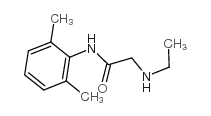Pharmacokinetics of lidocaine and its metabolite in peridural anesthesia administered to pregnant women with gestational diabetes mellitus.
Elaine Christine Dantas Moisés, Luciana de Barros Duarte, Ricardo de Carvalho Cavalli, Maria Paula Marques, Vera Lúcia Lanchote, Geraldo Duarte, Sérgio Pereira da Cunha
Index: Eur. J. Clin. Pharmacol. 64(12) , 1189-96, (2008)
Full Text: HTML
Abstract
Peridural blockade with lidocaine, bupivacaine, and fentanyl is an anesthetic procedure extensively used in obstetrics, justifying the pharmacokinetic study of these drugs during labor.To investigate the influence of the physiopathological changes of gestational diabetes mellitus (GDM) on the pharmacokinetics of lidocaine and its metabolite monoethylglycinexylidide (MEGX) in pregnant women subjected to peridural anesthesia.Ten normal pregnant women (group 1) and six pregnant women with GDM (group 2) were studied, all of them at term. The patients received 200 mg 2% lidocaine hydrochloride without a vasoconstrictor by the peridural locoregional route. Maternal blood samples were collected at predetermined times for the analysis of lidocaine and MEGX by chromatography and pharmacokinetic analysis.The median pharmacokinetic parameters of lidocaine for groups 1 and 2 (P
Related Compounds
| Structure | Name/CAS No. | Molecular Formula | Articles |
|---|---|---|---|
 |
Monoethylglycinexylidide
CAS:7728-40-7 |
C12H18N2O |
|
Transplacental Distribution of Lidocaine and Its Metabolite ...
2015-07-01 [Reprod. Sci. 22 , 791-7, (2015)] |
|
Concentrations of dimethylaniline and other metabolites in m...
2015-01-01 [Food Addit. Contam. Part A. Chem. Anal. Control. Expo. Risk Assess. 32 , 1256-64, (2015)] |
|
MEGX test in hepatology: the long-sought ultimate quantitati...
1993-08-01 [J. Hepatol. 19(1) , 4-7, (1993)] |
|
Effect of 4% topical lidocaine applied to the face on the se...
2010-01-01 [Aesthet. Surg. J. 30(6) , 853-8, (2010)] |
|
Comparison of five commonly-available, lidocaine-containing ...
2012-05-01 [Aesthet. Surg. J. 32(4) , 495-503, (2012)] |